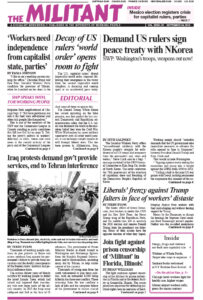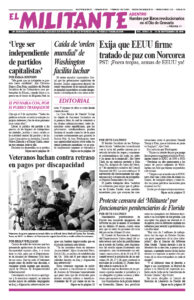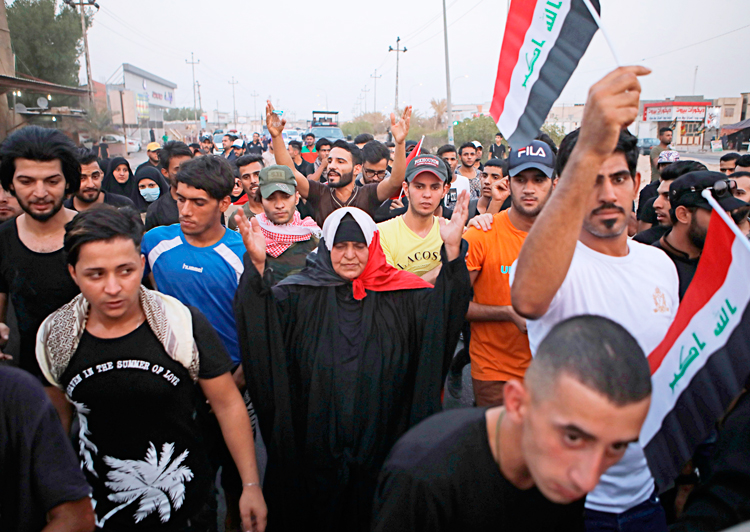Thousands of working people continue to join protests in Basra and across southern Iraq against the government’s failure to provide basic necessities and the deadly consequences of the Iranian rulers’ military and political influence there.
The actions follow years of bloody sacrifice by working people to defeat the hated Islamic State, which had seized and imposed their reactionary rule over large parts of the oil-rich country. In 2014 the Iraqi army collapsed and fled in the face of IS advances. The government of Prime Minister Haider al-Abadi turned to Washington and Peshmerga fighters from the Kurdish Regional Government, and to Shiite militias, including many led by Tehran, to help retake control of the country.
Thousands of young men from the south volunteered to join those militias, with an estimated 8,000 being killed in the three-year conflict. Those returning from the war confront a lack of jobs and the complete failure of the government to ensure crucial energy and water supplies.
At the same time, the dictatorship of Bashar al-Assad in Syria, backed by Moscow’s air power and ground troops from Iran’s Revolutionary Guard and its ally Hezbollah, have launched an offensive aimed at taking Idlib province, the last significant stronghold of opposition forces. Against mounting pressure from Washington and Israel, the propertied rulers in Iran are pressing to consolidate their influence in both Syria and Iraq.
Since sharply contested Iraqi elections in May, no party has been able to pull together a majority to rule. The largest vote getter was Shiite cleric Muqtada al-Sadr, long an outspoken critic of Washington’s intervention in Iraq, but today an ally of the U.S. rulers and Abadi. The opposition bloc is led by former Prime Minister Nouri al-Maliki and other factions with close ties to Iran, led by paramilitary leader Hadi al-Amiri.
As part of the effort to blunt Tehran’s influence, Washington is pushing both Sunni and Kurdish representatives to join Sadr and Abadi’s coalition, giving them a majority.
Since July 8, demonstrations in Iraq have targeted Tehran’s military and political intervention and the frequent electrical outages, unemployment, and the lack of safe drinking water in Basra, other southern provinces, and in Baghdad. The actions began after the Iranian government cut electrical supplies to Iraq. In addition, some 30,000 people have been hospitalized in Basra after drinking polluted water.
At least 10 people have been killed during protests in Basra since Sept. 3. “Security forces have been using tear gas and live ammunition to break us up, but that is making us more adamant to continue,” protester Nabil al-Assadi told Al Jazeera.
On Sept. 6 demonstrations shut down Umm Qasr, Iraq’s only large sea port, less than 40 miles south of Basra. The port handles the vast majority of Iraq’s imports, including much of its food supply. The Iranian consulate in Basra was attacked Sept. 7 by crowds chanting “Iran out, out, Basra remains free.”
The roots of the Iranian rulers’ intervention in Iraq lie in the counterrevolution they carried out to turn back the gains made by working people and the oppressed during the 1979 revolution that overthrew the U.S.-backed shah of Iran.
The cleric-led capitalist regime sought to consolidate its counterrevolution at home by extending it abroad, deploying its forces across the Mideast. It put together a substantial Hezbollah fighting force in Lebanon that has become part of the government there.
Tehran-backed militias are seeking to extend their sway inside Iraq. The Iranian government has provided them with short-range ballistic missiles and launchers. Their members have fought under the command of the Iranian Revolutionary Guard and Hezbollah in Syria, as part of the Iranian rulers’ efforts to bolster the al-Assad regime and extend their own reach.
And the Iranian military launched a precision missile attack into Iraq Sept. 8, targeting exile Iranian Kurdish fighters meeting in Koya.
Washington maintains 5,200 troops in Iraq, confirming in August they would remain indefinitely, as a counter to Tehran’s influence.
Moscow, Assad mount assault on Idlib
The Assad regime and its backers in Moscow and Tehran intensified their bombing offensive in Idlib Sept. 8. Moscow and Damascus carried out 68 airstrikes and dropped 19 barrel bombs — shells packed with explosives intended to kill and maim the maximum number of people. The strikes forced hundreds from their homes and hit one of the area’s hospitals. The densely populated province is home to some 3 million people. Nearly half of the population are recently arrived, driven from their homes under “de-escalation” agreements with Damascus and Moscow after brutal assaults.
Prior to the bombardment of Idlib, the governments of Russia and Iran rejected appeals by the Turkish government to hold off its attack. Some 40 percent of the province is held by a coalition of Islamist groups backed by Ankara. Other parts are run by a former al-Qaeda group.
The Turkish rulers fear mass flight toward the border that could add to the some 3.5 million Syrians already in the country.
Tens of thousands of Syrians in Aleppo, Hama and Idlib joined demonstrations against Assad and Moscow’s intervention on Sept. 7, the Syrian Observatory for Human Rights reported. These were the largest public protest in Syria since the uprising against Assad’s rule in 2011 was drowned in blood by the dictatorship, opening a seven-year civil war.
The various Islamist and pro-Turkish government forces who control Idlib have erected gallows in town centers to terrorize anyone considering surrendering to coerce them into staying under the bombardment.
Washington, with over 2,000 troops in Syria, and significant air power in the region, admitted recently it planned to stay. Most of the U.S. rulers’ troops are deployed in areas controlled by the Kurdish-led Syrian Democratic Forces, which occupies some 25 percent of the country including much of the oil supply.


